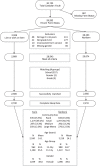Sleep in Farm Adolescents
- PMID: 30488583
- PMCID: PMC7379526
- DOI: 10.1111/jrh.12341
Sleep in Farm Adolescents
Abstract
Purpose: The objectives were to: (1) describe sleep timing and patterns among adolescents who live or work on farms; (2) compare these sleep characteristics to those of nonfarm adolescents; (3) explore whether the above sleep and farm versus nonfarm differences varied by age and gender.
Methods: Participants were aged 11-16 years and were abstracted from the 2014 Canadian Health Behaviour in School-aged Children study. Records from 2,160 farm adolescents were frequency matched (by school, gender, and grade) to records from 2,210 nonfarm adolescents. Participants self-reported their bedtimes and wake-up times on weekdays and weekends.
Findings: Among farm adolescents, average nightly sleep duration (hours:minutes) ranged from 08:34 among 14- to 16-year-old girls to 09:21 among 11- to 13-year-old girls. Approximately 24% to 32% of farm adolescents did not meet minimal sleep duration targets. For 11- to 13-year-olds, sleep characteristics did not differ according to farm status. However, for 14- to 16-year-olds, farm adolescents had shorter sleep durations than nonfarm adolescents (23 minutes for boys, P = .02; 20 minutes for girls, P = .06). Furthermore, a greater proportion of 14- to 16-year-old farm boys had sleep duration values less than the recommended 8 hours/night (27.7% vs 19.6%, P = .05).
Conclusions: This study profiles the sleep experiences of 11- to 16-year-old farm adolescents. Almost 1 in 3 of these adolescents did not get adequate sleep. Older adolescents who lived or worked on a farm slept less than comparably aged nonfarm adolescents. This may reflect their participation in morning chores essential to the farm operation and may increase their injury risk.
Keywords: adolescent; epidemiology; farmers; health surveys; sleep.
© 2018 The Authors. The Journal of Rural Health Published by Wiley Periodicals, Inc. on behalf of National Rural Health Association.
Figures
Similar articles
-
Sleep duration estimates of Canadian children and adolescents.J Sleep Res. 2016 Oct;25(5):541-548. doi: 10.1111/jsr.12410. Epub 2016 Mar 30. J Sleep Res. 2016. PMID: 27027988
-
How Are Adolescents Sleeping? Adolescent Sleep Patterns and Sociodemographic Differences in 24 European and North American Countries.J Adolesc Health. 2020 Jun;66(6S):S81-S88. doi: 10.1016/j.jadohealth.2020.03.013. J Adolesc Health. 2020. PMID: 32446613
-
Associations of self-reported sleep disturbance and duration with academic failure in community-dwelling Swedish adolescents: sleep and academic performance at school.Sleep Med. 2015 Jan;16(1):87-93. doi: 10.1016/j.sleep.2014.09.004. Epub 2014 Sep 19. Sleep Med. 2015. PMID: 25441744
-
Frequency of Vigorous physical activity and sleep difficulty in adolescents: A multiply-country cross-sectional study.Complement Ther Clin Pract. 2024 May;55:101843. doi: 10.1016/j.ctcp.2024.101843. Epub 2024 Mar 4. Complement Ther Clin Pract. 2024. PMID: 38507878 Review.
-
[Sleepiness among adolescents: etiology and multiple consequences].Encephale. 2023 Feb;49(1):87-93. doi: 10.1016/j.encep.2022.05.004. Epub 2022 Aug 12. Encephale. 2023. PMID: 35970642 Review. French.
Cited by
-
Working hours, sleep, and fatigue in the agriculture, forestry, and fishing sector: A scoping review.Am J Ind Med. 2022 Nov;65(11):898-912. doi: 10.1002/ajim.23418. Epub 2022 Jul 26. Am J Ind Med. 2022. PMID: 35880742 Free PMC article.
-
Profile and risk factors in farmer injuries: a review based on Haddon matrix and 5 E's risk reduction strategy.Front Public Health. 2024 Jun 6;12:1322884. doi: 10.3389/fpubh.2024.1322884. eCollection 2024. Front Public Health. 2024. PMID: 38903585 Free PMC article. Review.
-
Protecting Young Agricultural Workers: The Development of an Online Supervisor Training.J Agromedicine. 2022 Oct;27(4):359-367. doi: 10.1080/1059924X.2021.1979155. Epub 2021 Sep 19. J Agromedicine. 2022. PMID: 34538218 Free PMC article.
References
-
- Jessor R. Adolescent development and behavioral health In: Matarazzo JD, ed. Behavioral Health: A Handbook of Health Enhancement and Disease Prevention. Indianapolis, IN: Wiley; 1984:69‐90.
-
- Shochat T, Cohen‐Zion M, Tzischinsky O. Functional consequences of inadequate sleep in adolescents: A systematic review. Sleep Med Rev. 2014;18(1):75‐87. - PubMed
-
- Durmer JS, Dinges DF. Neurocognitive consequences of sleep deprivation. Semin Neurol. 2005;25(1):117‐129. - PubMed
Publication types
MeSH terms
Grants and funding
LinkOut - more resources
Full Text Sources
Medical



